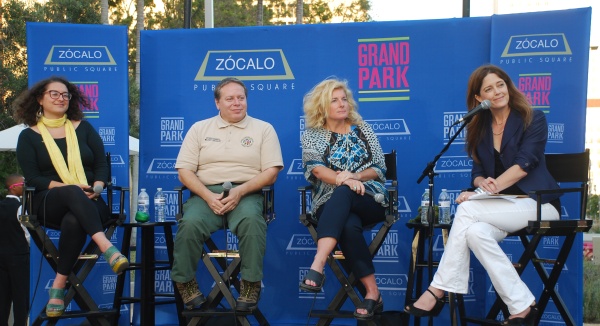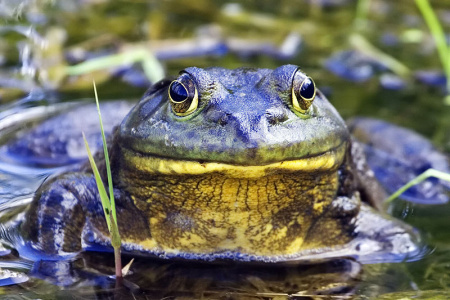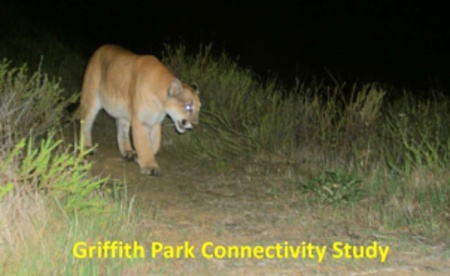“What single animal represents Los Angeles to you?” was the first question posed by moderator and author Kathryn Bowers at the recent public panel discussion “Does Los Angeles Appreciate Its Wild Animals?” Natch, you had to wait until the end of the discussion to hear the responses, but the interim dialogue provided enough food for thought for the 100+ folks who came out to expand their wildlife horizons.
Held outside near a fountain in the early evening at Downtown L.A.’s Grand Park, the evening talk-about brought together three panelists to chat with Bowers on the nature of nature in Los Angeles.

Part of the Zocalo Public Square series of lectures, this animal-themed event was a chance for panelists to speak about their local animal kingdom passions as well as share stories about their critter encounters, loves and lessons. From the start, Pratt claimed amphibians and reptiles as her personal favs, Higgins opted for her love of invertebrates and insects while Randall seemed right at home with discussing the “dangerous mammals” aka bears, coyotes and mountains lions.
Non-natives critters and their impact on the environment was a big theme of the evening. Pratt discussed the destruction when bullfrogs entered native streams; Randall mentioned the red fox which has overtaken its native gray fox cousin; Higgins brought up the Eastern fox squirrel that’s cashing into the territory of the native squirrels.

Panelists were eager to answer the question: What’s constitutes wild space in Los Angeles? “Any place can be a place for animals, even your balcony in your apartment,” declared Pratt who championed the NWF’s Certified Wildlife Habitat program which advocates using native plants to attract insects, birds, etc.
“Just make sure your backyard doesn’t become a MacDonald’s for wild animals,” added Randall who has seen his share of folks knowingly and unknowingly feeding critters on their property with leftover cat food, un-lidded garbage cans, etc.
Higgins also agreed that anyplace could be a place for wild things, citing the popular Vaux’s swifts that roost nightly in a chimney in downtown Los Angeles during their twice a year migration. In addition, Higgins also agreed with Pratt about backyards being mini wildlife “sanctuaries” and pointed to the numerous NHM’s Citizen Scientist programs: average residents are asked to keep an eye out, photograph and record various critters from ladybugs, lizards, reptiles, butterflies and more.
While the discussion kept to a personal appreciation for wildlife, the moderator and panel didn’t delve into civic policy or governmental regulations that directly affect animals in the Los Angeles area. Noticeably absent were references to the recent destruction of habitat at the Sepulveda Wildlife Basin by the Army Corp of Engineers and the planned removal of wilderness acres at Griffith Park by Forest Lawn developers for more cemetery plots.
Still, the anticipation grew and after a Q & A session, each panelist revealed what they would vote as the Official Animal of Los Angeles, Higgins choose the resourceful harvester ants; Randall opted for a raccoon (“they are everywhere and they have little hands”) Pratt put her bid on P-22, the mountain lion that makes his home in Griffith Park. “Come on,” she said. “He has a Twitter account with more than 1,000 followers.”

Indeed, the audience was behind Pratt and P-22, although one audience goer wished he had a better name. “We could call him James Dean because of the bust of James Dean that’s up near the Observatory,” he said.
Hmmm…so is it appropriate to name one animal as the official animal of Los Angeles? Sure, P-22 does have rock star status in our star-struck world — and his influence certainly makes folks sit up and take notice. How cool is it that a wild thing is roaming not more than 6+ miles from Hollywood and Highland?
But does that lone critter — equally revered and feared — really represent the Los Angeles environs?
We have blue whales off our coast in the summer, possums in our parks, big horn sheep in our mountains, yellow garabaldi swimming in wake of the Channel Islands, hummingbirds in our canyons and lizards on our fences.
What would be the most appropriate animal to represent Los Angeles? Let’s ponder this question some more Angelenos…we’ll get back to you…
— Brenda Rees, editor
